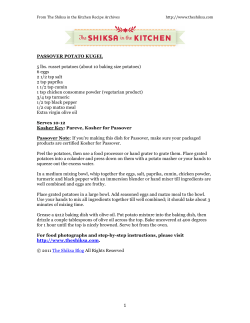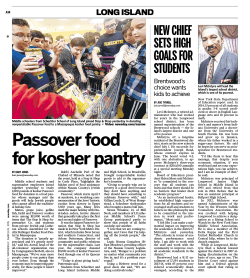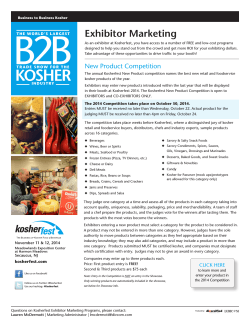
Passover Holiday Guide
Passover The Kosher Customer Reaching Across the Aisle Kosher foods, although based on one of the world’s oldest dietary laws, are among the fastest growing consumer trends in food processing. While here in the United States, home to 40 percent of the world’s Jewish population or about 6.15 million consumers, kosher food has always occupied an important marketing sector, but it is not Jews fueling this explosive growth in kosher foods. More and more, we are seeing that kosher foods are increasingly attractive to the non-Jewish population; the population that now makes up the leading and fastest-growing consumer base for kosher products. The growing popularity resulted in a U.S. kosher market valued at $12.5 billion in 2008, an increase of 64 percent since 2003. “At first I thought that kosher meant food for Jewish people. Now I realize that people equate kosher with quality.” Alice Mok, Marketing Director of Twin Marquis Trading Corporation of New York. Wholesome. Fresh. Highest quality. Kosher quality. Rigorously monitors. Regularly inspects. Standards. According to Karen Barrow of The New York Times, kosher food is “…an ancient diet [that] has become one of the hottest new food trends.” She notes that more and more supermarket shoppers are “going kosher.” Why? Because these shoppers are “…convinced that the foods are safer and better for health.” The Kosher Customer Who Buys Kosher? Millions of people throughout the world limit their food consumption, and seek out the kosher symbol to insure that their preferences are being addressed. According to market studies, the appeal of kosher foods transcends the interest of any one specific ethnic group. Consumers of kosher foods include Jews, Muslims and members of other religious denominations, vegetarians, those with lactose intolerance, and those who believe that “kosher is better.” The Jewish Market Jewish consumers comprise of approximately 45% of the kosher market. Integrated Marketing Communications reports that approximately 2.5 million Jews consume kosher food products. The Islamic Community Millions of Muslims throughout the world follow a dietary regimen similar to the kosher code. Since they recognize that food products bearing a kosher symbol conform to the requirements of “Halal,” foods certified as kosher have a broad appeal to Muslims. Other Religious Denominations Seventh Day Adventists, and other Christian sects have dietary restrictions similar to Judaism. Pork, for example, is not permitted to Seventh Day Adventists. A kosher symbol on food products guarantees that their dietary concerns have been met, and that the food is permissible for their use. Lactose Intolerant Consumers Lactose intolerance afflicts millions of people. Moreover, people with allergies to dairy products may have a life threatening reaction to the most minute consumption of milk derived ingredients. Kosher law requires complete segregation between meat and milk. Gluten-Free Consumers During Passover, wheat, oats, barley, rye and spelt in any form other than matzoh is prohibited. As a result, many of the bread products designed for passover are gluten-free. (ahead of the trend by 3,000 years!) Vegetarians Vegetarians, due to a variety of considerations, exclude meat, poultry and fish from their diet. The Kosher Customer Market research indicates that fully 62 percent of people who buy kosher foods do so for reasons of quality. A third bought kosher because they believe that kosher food safety standards are better than with traditional supermarket foods. Only 15 percent of respondents say they buy kosher food because of religious rules. Quality Standards Religion • Consumers may choose from 75,000 kosher food products. • Nearly 10,000 companies produce products for the kosher market. • Approximately, 3,000 new products are introduced into the kosher market annually. • Consumers spend approximately $165 billion on kosher products, as compared to $250 million almost 25 years ago. • According to John McMillan, a food analyst at Prudential Bache Securities, the “kosher seal “is equivalent to what the Good Housekeeping Seal meant in the 1950’s. • The Wall Street Journal quoted consultant Stephen Hall who said that health conscious folks see “benefits in the quality control and lack of additives” in kosher foods. Source: Integrated Marketing Communications, Inc. When is Passover? April 2015 / 5775 SUNDAY MONDAY TUESDAY WEDNESDAY THURSDAY FRIDAY SATURDAY 1 2 3 4 7 8 9 10 11 5 6 12 13 14 15 16 17 18 19 20 21 22 23 24 25 26 27 28 29 30 Passover May 2015 / 5775 SUNDAY MONDAY TUESDAY WEDNESDAY THURSDAY FRIDAY SATURDAY 1 2 3 4 5 1 2 3 4 5 6 7 8 9 10 11 12 13 14 15 16 17 18 19 20 21 22 23 24 25 26 27 28 29 30 Shavuot The Kosher Customer Passover is a Jewish holiday which is celebrated for eight days in the springtime. During Passover observant Jews follow a second set of dietary laws which are “overlaid” on top of the everyday kosher rules. The Passover dietary rules restrict the use of grains that can ferment and become leavened: wheat, barley, spelt, oats and rye. During Passover only unleavened grains are allowed. Thus wheat flour is permitted only if it is baked into Matzah (unleavened bread). It is an Eastern European custom to also not have any legumes (like corn or corn syrup, beans, rice, etc.) There are certain hard-to-find items – especially products made without soy or corn – that are specially made for consumption during Passover. For some families managing restricted diets, Kosher for Passover foods can offer options not available otherwise. Kosher for Passover foods can be particularly helpful to those managing a corn allergy or soy allergy. The Passover Seder The Passover Night Seder Table is steeped in religious and symbolic meaning, and as the Jews partake of the meal, they are learning / recalling their deepest traditions and teachings. While the main meal of the Passover Seder often varies from country to country – and family to family – there are several specific ingredients to a Seder that are part of every celebration. This is because they symbolize specific portions of the story that are traditionally related during the Passover Seder and partaking of the food becomes a tangible metaphor for taking in the teaching and the history; and is, of course, part of the whole meaning of being Jewish. As an example, on each Seder night, it is a commandment for Jewish people to drink four cups of wine, each containing a minimum of 3.5 oz. This ritual symbolizes freedom of the Jewish people from Egypt and the four (4) phrases of redemption referenced in the Bible Each Person 4 Cups x 3.5 oz. = 14 oz. Each Table (average 6) 10 x 14 oz. = 140 oz. + Elijah’s Cup (4 oz.) = 144 oz. Each Passover 2 Dinners = 288 oz. or 12 bottles of wine Passover April 3-11, 2015 Essential Passover Shopping List Grocery Yehuda 5lb Pack of Matzo Yehuda Egg Matzo Yahuda Gifilte Fish Yehuda Matzo Farfel Yehuda Cake Meal Yehuda Matzo Meal Gefen Macaroons Gefen Borscht Gefen Cake Mixes Gefen Potato Pancake Mix Gefen Sardines Gefen Tuna Fish Lipton Matzo Ball Soup Gefen Apple Juice Kedem Grape Juice Prune Juice Gefen Duck Sauce Wissotzky Tea Elite Coffee Sugar David’s Kosher Salt Gefen Spices Shufra Cocoa Powder Lay’s Potato Chips Manhattan Choc. Jelly Rings Bartons Chocolates Elite Chocolate Bars Almonds Savion Marshmellows Savion Fruit Slices Gefen Lemon Juice Gefen Ketchup Gefen Vinegar Gefen Mayonaise Gefen Mustard Gefen Honey Horse Radish Sauce Gefen Cucumbers in Brine Savion Cereals Gefen Oil Fox’s Ubet Syrup Yehuda Memorial Candles Yehuda Sabbath Candles Frozen Gefilte Fish Whipped Toppings Coffee Whitener Potato Latkes Blintzes Chopped Liver Delicatessen Horseradish Herring Pickles Kugels Whitefish Salad Salami Hot Dogs Cold Cuts Dairy Cheese Milk Sour Cream Butter Butterfields Margarine Yogurt Pudding Eggs (Baytzah) Bakery Cakes Cookies Meat Chicken Turkey Roasts Brisket Lamb Shank (Zeroa) Seafood Whitefish Carp Tilapia Salmon Produce Fruits (Charoset) Vegetables (Karpas/Chazeret) Bitter Herbs (Moror) Potatoes Holiday Helpers Aluminum Foil Candles Plastic Plates and Utensils Napkins & Doilies Wines Kedem Traditional Wine Baron Herzog (California) Bartenura (Italy) Barkan (Israel) Teal Lake (Australia) Alfasi (Chile)
© Copyright 2025











